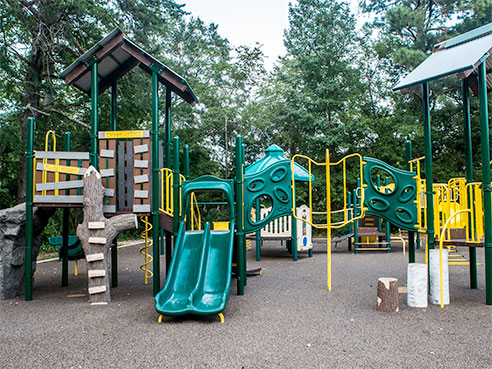 Parks with low play value have physical and social barriers for play activities. These include limited open areas with closely mown grass for open play, and lack of security fencing. Such park environments serve only limited play purpose, with static rather than dynamic features of play equipment, and do not support children’s daily requirements for physical activity. Parks with low play value often lack environmental biodiversity features or loose play materials for manipulation.The play value of parks, playgrounds and open play spaces is higher in affluent communities than in nonaffluent communities, according to research from occupational therapy students in the University of Alabama at Birmingham School of Health Professions.
Parks with low play value have physical and social barriers for play activities. These include limited open areas with closely mown grass for open play, and lack of security fencing. Such park environments serve only limited play purpose, with static rather than dynamic features of play equipment, and do not support children’s daily requirements for physical activity. Parks with low play value often lack environmental biodiversity features or loose play materials for manipulation.The play value of parks, playgrounds and open play spaces is higher in affluent communities than in nonaffluent communities, according to research from occupational therapy students in the University of Alabama at Birmingham School of Health Professions.
The findings, published in the International Journal of Environmental Research and Public Health, suggest that the disparity in play spaces can affect the physical and psychological health benefits that children receive from play.
Play value refers to the usability of any environmental features or play areas as a setting for play, generating diverse play opportunities and experiences that suit various children’s needs, motivations and abilities.
“Children learn through play, and studies have shown that access to safe, well-designed parks provides health benefits to children,” said Gavin Jenkins, Ph.D., OTR/L, assistant professor in the Department of Occupational Therapy who mentored the student research project. “Understanding the quality of play environments will help communities ensure that all children have access to imaginative, stimulating play environments.”
The four UAB OT students, Amy Maher, Emily Rose, Kristina Gregory and Megan Cotton, studied six parks in Mountain Brook, Alabama, and five parks in Irondale, Alabama. According to the most recent United States Census Bureau American Community Survey, the median annual income for Mountain Brook ($131,281) is more than double that of Irondale ($50,157), which is below the U.S. average.
The students, paired in teams of two, conducted independent evaluations of each play park using the Playable Space Quality Assessment Tool, or PSQAT. The PSQAT provides scores based on location, play value, and care and maintenance. Mountain Brook’s median scores were nearly 50 percent higher in play value (61.00 vs. 43.50) and care and maintenance (76.43 vs. 53.57) and almost double Irondale’s location score (82.14 vs. 47.14).
“The children who were actively using the Mountain Brook play spaces appeared to have all needs available, such as clean restrooms, accessibility to play structures and spaces, and cleared walking surfaces,” Maher said. “There was also a noticeable sense of safety as police or maintenance was present while the children engaged with other children in their play environments.”
 The student authors say parks with high play value draw children and young people to visit, and also provide opportunities for a variety of play activities, including allowing children to adapt park elements for their own play purposes and support free exploration.The student authors say parks with high play value draw children and young people to visit, and also provide opportunities for a variety of play activities, including allowing children to adapt park elements for their own play purposes and support free exploration. These characteristics of parks entice children and young people to return time and again for repeat visits.
The student authors say parks with high play value draw children and young people to visit, and also provide opportunities for a variety of play activities, including allowing children to adapt park elements for their own play purposes and support free exploration.The student authors say parks with high play value draw children and young people to visit, and also provide opportunities for a variety of play activities, including allowing children to adapt park elements for their own play purposes and support free exploration. These characteristics of parks entice children and young people to return time and again for repeat visits.
On the other hand, parks with low play value have physical and social barriers for play activities. These include limited open areas with closely mown grass for open play, and lack of security fencing. Such park environments serve only limited play purpose, with static rather than dynamic features of play equipment, and do not support children’s daily requirements for physical activity. Parks with low play value often lack environmental biodiversity features or loose play materials for manipulation, the authors suggest.
“Studies like this could be used to help communities determine how well they are doing, but perhaps more importantly help them to prioritize the improvements needed to their sites,” Jenkins said. “This study provides a further window into the challenges of providing suitable play environments and opportunities for children and young people who live in low-income neighborhoods.”
“Improving parks and playgrounds would encourage families to use the play spaces, and that in-turn would give children more access to active play, which is central to child development and social, emotional, cognitive and physical well-being,” Maher said.
The students’ research was part of their final research project supported by their Occupations of Infants, Children and Adolescents class in the Master of Science in Occupational Therapy program. As part of the program, the students learn the importance of play, stages of play, functions of play, and more, for their careers as OTs.
In the conclusion of this study, the students noted that their research provided them “a further window into the challenges of providing suitable play environments and opportunities for children and young people who live in low-income neighborhoods.”